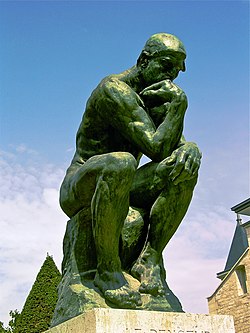The Thinker
| The Thinker | |
|---|---|
 | |
| Artist | Auguste Rodin |
| Year | 1902 |
| Type | Bronze and Marble |
| Location | Musée Rodin, Paris |
"The Thinker" is a bronze and marble sculpture by Auguste Rodin, whose first cast, of 1902, is now in the Musée Rodin in Paris; there are some 20 other original castings, as well as various other versions, studies, and posthumous castings. It depicts a man in sober meditation battling with a powerful internal struggle.[1] It is often used to represent philosophy.
Historical information
Originally named "The Poet", the piece was part of a commission by the Musée des Arts Décoratifs, Paris, to create a monumental portal to act as the door of the museum. Rodin based his theme on The Divine Comedy of Dante and entitled the portal The Gates of Hell. Each of the statues in the piece represented one of the main characters in the epic poem. Some critics believe "The Thinker" was originally intended to depict Dante at the Gates of Hell, pondering his great poem. However, there are "questionable" aspects to this interpretation, including that the figure is naked, Dante is fully clothed throughout his poem, and that the figure, as used, in no way corresponds to Dante's effete figure.[2] (In the final sculpture, a miniature of the statue is waiting atop the gates, pondering the hellish fate of those beneath him.) The sculpture is nude, as Rodin wanted a heroic figure in the tradition of Michelangelo, to represent intellect as well as poetry.
This detail from the Gate of Hell was first named "The Thinker" by foundry workers, who noted its similarity to Michelangelo's statue of Lorenzo de Medici called "Il Penseroso" (the Thinker).[3]
Additional casts

More than 20 monumental-sized bronze casts of the sculpture are in museums around the world. In addition, there are sculptures of different study size scales and plaster models in both monumental and study sizes. Some newer castings have been produced posthumously and are not considered part of the original production.
Rodin made the first small plaster version around 1880. The first large-scale bronze cast was finished in 1902, but not presented to the public until 1904. It became the property of the city of Paris—thanks to a subscription organized by Rodin admirers—and was put in front of the Panthéon in 1906. In 1922, it was moved to the Hôtel Biron, which was transformed into a Rodin Museum. In the spring of 2011, the cast of "The Thinker" was moved temporarily to the Smart Museum of Art at the University of Chicago in Hyde Park. This cast was a bequest from Harold H. Swift. The cast can be found at the Cantor Arts Center at Stanford University.[4]
The first cast sculpture can be found in front of Grawemeyer Hall on the University of Louisville Belknap Campus in Louisville, KY. Made in Paris, it was first displayed at the St. Louis World's Fair in 1904 and was then given to the city. This sculpture was the only cast created by the lost-wax casting method.[5]
| The Thinker | |
|---|---|
| File:The Thinker, Louisville, KY.jpg | |
| Artist | Auguste Rodin |
| Year | 1902-1904 |
| Type | Bronze |
| Location | Louisville, KY, United States |
List of sculptures
"The Thinker" has been cast in multiple versions and is exhibited around the world.
See also
- The "Penseur", a poem by Philadelphia poet Florence Earle Coates "on seeing the famous statue"
References
- ^ Statues — The Thinker
- ^ Elsen, Albert L., ‘’Rodin’s Gates of Hell’’, University of Minnesota Press, Minneapolis MN, 1960 p. 96
- ^ Elsen, Albert L., ‘’Rodin’s Gates of Hell’’, University of Minnesota Press, Minneapolis MN, 1960 p. 77
- ^ "The Thinker, one of the most famous works of art in the world, comes home to Stanford's Cantor Arts Center". Stanford University. 2012. Retrieved 26-January 2012.
{{cite web}}: Check date values in:|accessdate=(help) - ^ "U of L Belknap Campus Tour, page 2". University of Louisvile. 2000. Retrieved 15-November 2010.
{{cite web}}: Check date values in:|accessdate=(help); Cite has empty unknown parameter:|coauthors=(help)
External links
- Link to The Thinker on the official website of the Musée Rodin.
- The Thinker Inspiration, Analysis and Critical Reception
- The Thinker project, Munich. Discussion of the history of the many casts of this artwork.
